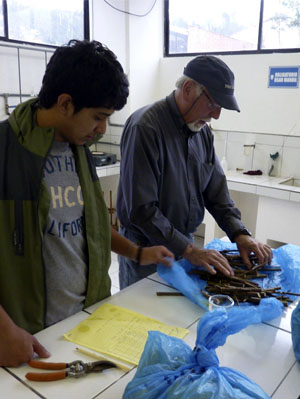
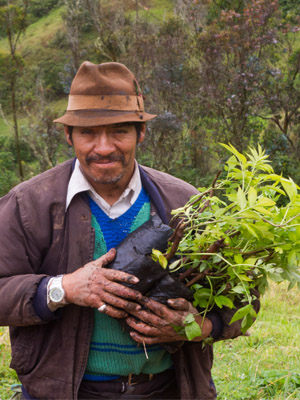

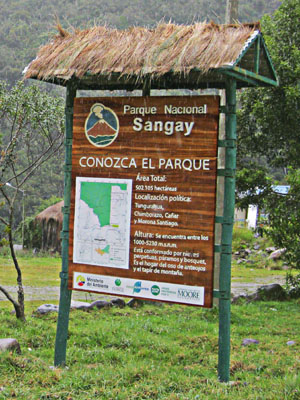


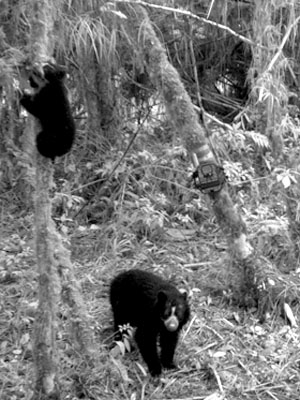
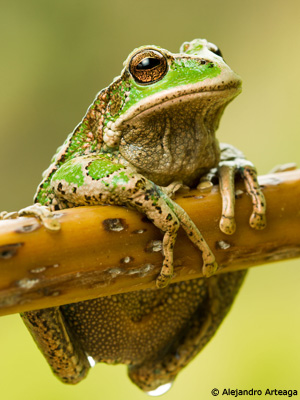
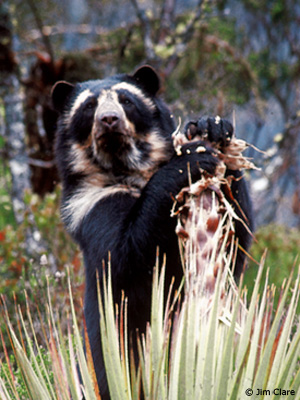
News
25 April 2016 - Scientists at Fundación Cordillera Tropical have published a study examining forage production of the elderberry tree, a species used in silvopastoril systems at high-elevation. A principal limitation to the broad implementation of silvopastoral systems at high-elevation is the lack of information about tree growth and forage production. The paper aims to generate this information, ensuring that future practitioners in Ecuador have access to scientifically robust information for program design. Download: Attachments
Fundación Cordillera Tropical wins prestigious international sustainability award
25 June 2015 - Fundación Cordillera Tropical has won the 2015 National Energy Globe Award for Ecuador in recognition of its commitment to creating sustainable livelihoods in the southern Ecuadorian Andes. Energy Globe, the world award for sustainability, recognized FCT's program to promote pasture restoration on private land bordering Sangay National Park
17 March 2015 - Fundación Cordillera Tropical reports that researchers Carol Harden (University of Tennessee), Kathleen Farley (San Diego State University), Leah Bremer (Stanford University, California) and James Hartsig (University of Tennessee) have published the results of their study investigating the synergies and trade-offs of managing páramo landscapes for the production of multiple ecosystem services in Ecuador.
5 February 2015 - Laura Lojano, Fundación Cordillera Tropical's Project Coordinator, recently visited the Research Center for Sustainable Systems for Agricultural and Ranching Production in Colombia. Here she shares her experience of visiting farms with working silvopastoral models.
New photographs reveal the presence of the mountain tapir in southern Sangay National Park, Ecuador
25 November 2014 - Fundación Cordillera Tropical reports the presence of the critically endangered mountain tapir (Tapirus pinchaque) in southern Sangay National Park. The species had all but disappeared according to local residents, who nevertheless confirm its historical presence. Five series of photographs obtained between 2013 and 2014 suggest that the region hosts some of only 2,500 individuals worldwide.
A puma ate my alpaca: Human-Wildlife Conflicts in the Nudo del Azuay
2 October 2014 - This past Thursday, FCT Senior Scientist Becky Zug, Board Member Stuart White, and Executive Director Catherine Schloegel were in Quito to contribute to a national conversation about how to reduce and mitigate human-wildlife conflicts.
New silvopastoral project plants trees in pastures adjacent to Ecuador's Sangay National Park
5 August 2014 - We've planted thirteen thousand trees. On a recent Tuesday morning, Eugenio and Milton finished digging yet another hole on a rain-soaked hillside. The brothers along with six Fundación Cordillera Tropical employees were completing a project to plant thirteen thousand trees in cattle pastures bordering Sangay National Park in south-central Ecuador.
New documentary, ¨My Place¨, portrays Fundación Cordillera Tropical's conservation work
26 June 2014 - Fundación Cordillera Tropical announces the premiere of a short documentary made by Actuality Media in association with the University of Tampa, Florida (USA) titled, ¨My Place¨. The short highlights the conservation work of Fundación Cordillera Tropical and local landowners to conserve Sangay National Park.
Blog: A day of field work in the Tropical Andes
7 May 2014 - It was still early in our ten hour field day for water to be sloshing inside my right boot, but when I slipped off a moss-covered rock, most of my body narrowly avoided falling into the Dandayacu River, except for my right foot. How did I find myself here? I had become an assistant Andean bear researcher and for three days I accompanied Fundación Cordillera Tropical field staff through the cloud forests of Sangay National Park to search for the endangered Andean bear.
28 Jan. 2014 - Pyramid lives on! A uniquely patterned Andean, or spectacled bear, with a white inverted pyramid on its brow has appeared once again in our forest photographs. First photographed in 2009, Pyramid has been consistently identified in photographs over the past three and a half years. Today Pyramid continues to live within a private reserve abutting Sangay National Park, one of Ecuador’s largest national parks.
Spectacled bear conservation updates
16 Sept. 2013 -The Don Oso Program has won an award for “Best Lessons Learned” from the Eco-Index at Rainforest Alliance. Employees at the Fundación Cordillera Tropical trained 15 school teachers in the Cañar Province in the application of the program, ¨Don Oso visits my School¨. Researcher Becky Zug examines how the Andean bear uses private properties outside of national parks. Read all the updates.
Ten community leaders named ¨Disney Conservation Heroes¨
17 May 2013 - The Corps of Community Park Guards have been named Disney Conservation Heroes in recognition of their work to protect and conserve the endangered spectacled bear and its associated habitat, reports Fundación Cordillera Tropical. The award recognizes local citizens from around the world for their tireless efforts to save wildlife, protect habitats, and educate communities.
New Exhibit ¨The Spectacled Bear - Symbol of the Andes¨ Opens
28 February 2013 - You are cordially invited to the exhibit about the spectacled bear, its importance, and the efforts to conserve this animal. The exhibit opens February 28th and will run through March 24th. Be sure not to miss the March 7 talk: ¨Conservación del oso de anteojos en el Ecuador¨ (in Spanish) at the Museo Pumapungo screening room. Also be sure to join us for the March 14th talk: ¨Spectacled Bears: Shadows of the Forest with Special Film Screening at 7 p.m. (in English).
First demarcation of Sangay National Park boundary
14 December 2012 - Fundación Cordillera Tropical and Ministry of Environment officials have demarcated the southern limit of Sangay National Park. The two institutions collaborated to install first-ever boundary markers and new signage in a 20 kilometer stretch of one of the park’s most densely populated regions. The park’s southern limit had previously been outlined on a map, but these efforts constitute its first field demarcation.
Fundación Cordillera Tropical joins the Mountain Partnership
24 July 2012 - Fundación Cordillera Tropical announces its new membership in the Mountain Partnership. This voluntary alliance of more than 200 organizations worldwide is dedicated to improving the lives of mountain people and protecting mountain environments around the world. Mountains cover one-quarter of the earth’s surface, and we are proud to share knowledge and information to better protect tropical Andean ecosystems and their mountain communities.
New study explores land-use and land cover change over 50-year period in the upper Mazar watershed
02 April 2012 - Shanley Thompson, Ph.D. student at the University of Victoria, Canada, and former Foundation volunteer, recently completed a novel analysis of land-use and land cover change between 1963 and 2010 in the upper Mazar watershed. She examined land-cover change using a combination of historical aerial photos and a 2010 satellite image, finding that changes in land cover relate to road construction/access, and changes in management on private lands. Read more at the link above (Spanish only).
FCT's Don Oso Program wins second award from Rainforest Alliance's Eco-Index
09 February 2012 - Fundación Cordillera Tropical's Don Oso Program has won a second award from Rainforest Alliance's Eco-Index for "Best monitoring & evaluation methodology" for the month of February 2012. The Don Oso program uses a combination of state-of-the-art camera traps, satellite imagery and local interviews to monitor the Andean bear and its habitat. The program was named ¨Eco-Initiative of the Month¨ in December 2010 for its focus on capacity building, wildlife research, and payments for environmental services.
FCT publishes innovative educational curriculum
09 January 2012 - Fundación Cordillera Tropical announces the publication of a 130-page Spanish-language curriculum and activity guide that uses the Andean bear to teach elementary students about endangered species conservation. The guide's seven units include hands-on classroom and take-home activities for use with 4th to 7th graders. Download the publication here.
The Andean Bear Gets a Helping Hand from Disney
18 October 2011 -The Disney Worldwide Conservation Fund (DWCF) announced that Fundación Cordillera Tropical and the Carnivore Coexistence Lab at the Nelson Institute for Environmental Studies at the University of Wisconsin-Madison, USA, are one of nearly 100 organizations worldwide that have been awarded an annual grant to support their project: Conservation of the Andean bear in Ecuador. Read more about the project and recent award here.
New Frog Species Discovered in Sangay National Park, Ecuador
7 July 2011 - Fundación Cordillera Tropical reports the discovery of a new frog species, the bamboo rain-peeper (Pristimantis bambu), in Sangay National Park, Ecuador. Catholic University biology student, Alejandro Arteaga, discovered this thumb-sized frog within the privately managed Mazar Wildlife Reserve, in the Park’s southern region. The bamboo rain-peeper is the second new frog species identified on the reserve in recent years, and its discovery, undoubtedly, merits an increase in efforts to catalogue and protect this region’s unique biodiversity.
Participatory monitoring protocol developed to study Andean bears
28 April 2011 - Fundación Cordillera Tropical and University of Wisconsin-Madison research scientists recently published an article about our community-based Andean bear monitoring program in the May 2011 issue of International Bear News. Over the past 8 months, researchers trained local community para-biologists, FCT staff, and local university students to use camera-trap to study the Andean bear. From September 2010 through January 2011, we photographed bears during 182 individual visits to our 10 trap stations (100%) during 1,321 trap nights. We believe that training local land stewards as para-biologists may be one way to assure the long-term conservation of Andean bears.
FCT's Don Oso Program recognized by the Rainforest Alliance's Eco-Index
8 December 2010 – Fundación Cordillera Tropical's Don Oso program has been named Project of the Month for December 2010 by the Rainforest Alliance's Eco-Index. The Eco-Index lauds the program as an Innovative Eco-Initiative for its work in capacity building, environmental services payments, parks and protected areas, and wildlife research. See the Eco-Index listing here.
'Don Oso' program aims to reduce retaliatory killing of the endangered Andean bear to zero in southern Sangay National Park
6 August 2010 – Fundación Cordillera Tropical announces a new program to mitigate conflicts between private property owners and the Andean bear (Tremarctos ornatus) in southern Sangay National Park. In Ecuador, the Andean bear is endangered due to habitat loss and hunting, often as a result of human/bear conflicts. Retaliatory killing of bears following attacks on cattle is considered one of the primary threats to long-term conservation of the species.
FCT biologist Lucas Achig consulted about Andean bear habitat conservation in Ecuador
22 May 2010 - Fundación Cordillera Tropical's Scientific Research and Monitoring Coordinator, Lucas Achig, was interviewed for a special article in the "Proyecto Páramo Andino" Series on Páramo Biodiversity. According to Achig, "[The Andean bear's] habitat includes so much area and so many other threatened species that conserving the bear implies conserving entire forests and páramos; these ecosystems are very biodiverse, and regulate and protect water sources for human populations." Read more at the link above (Spanish only).
15 March 2010 - Fundación Cordillera Tropical reports that in January of 2010 an ongoing research project by Alejandro Arteaga, a biology student at the Catholic University in Quito, identified two additional individuals of a critically endangered Andean poison dart frog, Hyloxalus anthracinus, in the montane forests of southern Sangay National Park.
Scientists discover Andean poison dart frog believed extinct since 1995
23 September 2009 – Fundación Cordillera Tropical announces that during a recent inventory scientists discovered a high-altitude Andean poison dart frog, believed to have been extinct, in southern Sangay National Park, Ecuador. Alejandro Arteaga, a biology student at the Catholic University of Quito, recorded an individual of the species Hyloxalus anthracinus (common name Andean poison dart frog or high altitude rocket frog) during a recent inventory of reptiles and amphibians. According to Eduardo Toral and Manuel Morales, biologists at the Catholic University of Quito, this species was last recorded on June 11, 1995, in the Mazan Protected Forest of Cajas National Park.
Payment for environmental services in Ecuador
August 2009 – Dr. Stuart White, Fundación Cordillera Tropical's founder and General Coordinator, was interviewed for an article by the Center for International Forestry Research (CIFOR), which has partnered with FCT for many years in Payment for Environmental Services (PES) research. The article, "Payments for environmental services: A matter of scale in Ecuador and Colombia," investigates the effectiveness of large versus small-scale PES schemes. White commented "Socio Bosque [the Ecuadorian government's new national PES scheme] was an important policy, given the lack of economic incentive to conserve forests; however, we do not yet know how this programme will affect local PES initiatives, which in several cases have also been efficient in conserving Ecuadorian forests."
Photos capture images of elusive Andean bear
March 2009 – Becky Zug, candidate for a Master's of Science at the University of Wisconsin-Madison, has used remote-sensored cameras to investigate how Andean bears use páramo and montane forest habitats. For 5 months, she monitored 17 cameras that were placed in a 1,000 hectare area in the Mazar watershed within southern Sangay National Park. Camera traps have only recently been used to study Andean bears. The cameras also captured photos of pumas, white-tailed deer, red brocket deer, and margays.